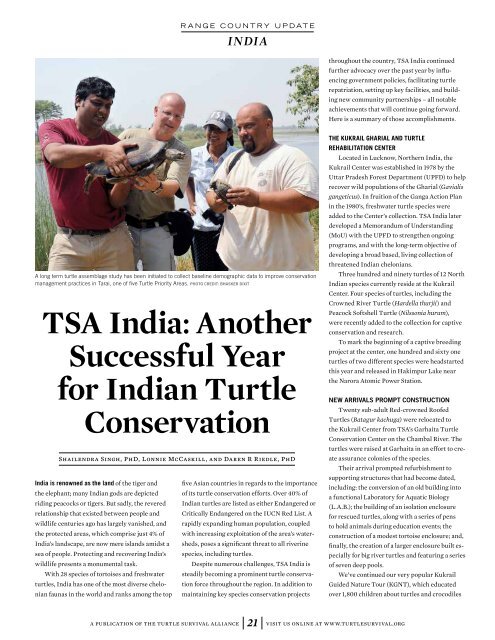Turtle Survival
2tUaeTbNi
2tUaeTbNi
Create successful ePaper yourself
Turn your PDF publications into a flip-book with our unique Google optimized e-Paper software.
RANGE COUNTRY UPDATE<br />
INDIA<br />
throughout the country, TSA India continued<br />
further advocacy over the past year by influencing<br />
government policies, facilitating turtle<br />
repatriation, setting up key facilities, and building<br />
new community partnerships – all notable<br />
achievements that will continue going forward.<br />
Here is a summary of those accomplishments.<br />
A long term turtle assemblage study has been initiated to collect baseline demographic data to improve conservation<br />
management practices in Tarai, one of five <strong>Turtle</strong> Priority Areas. PHOTO CREDIT: BHASKER DIXIT<br />
TSA India: Another<br />
Successful Year<br />
for Indian <strong>Turtle</strong><br />
Conservation<br />
Shailendra Singh, PhD, Lonnie McCaskill, and Daren R Riedle, PhD<br />
India is renowned as the land of the tiger and<br />
the elephant; many Indian gods are depicted<br />
riding peacocks or tigers. But sadly, the revered<br />
relationship that existed between people and<br />
wildlife centuries ago has largely vanished, and<br />
the protected areas, which comprise just 4% of<br />
India’s landscape, are now mere islands amidst a<br />
sea of people. Protecting and recovering India’s<br />
wildlife presents a monumental task.<br />
With 28 species of tortoises and freshwater<br />
turtles, India has one of the most diverse chelonian<br />
faunas in the world and ranks among the top<br />
five Asian countries in regards to the importance<br />
of its turtle conservation efforts. Over 40% of<br />
Indian turtles are listed as either Endangered or<br />
Critically Endangered on the IUCN Red List. A<br />
rapidly expanding human population, coupled<br />
with increasing exploitation of the area’s watersheds,<br />
poses a significant threat to all riverine<br />
species, including turtles.<br />
Despite numerous challenges, TSA India is<br />
steadily becoming a prominent turtle conservation<br />
force throughout the region. In addition to<br />
maintaining key species conservation projects<br />
THE KUKRAIL GHARIAL AND TURTLE<br />
REHABILITATION CENTER<br />
Located in Lucknow, Northern India, the<br />
Kukrail Center was established in 1978 by the<br />
Uttar Pradesh Forest Department (UPFD) to help<br />
recover wild populations of the Gharial (Gavialis<br />
gangeticus). In fruition of the Ganga Action Plan<br />
in the 1980’s, freshwater turtle species were<br />
added to the Center’s collection. TSA India later<br />
developed a Memorandum of Understanding<br />
(MoU) with the UPFD to strengthen ongoing<br />
programs, and with the long-term objective of<br />
developing a broad based, living collection of<br />
threatened Indian chelonians.<br />
Three hundred and ninety turtles of 12 North<br />
Indian species currently reside at the Kukrail<br />
Center. Four species of turtles, including the<br />
Crowned River <strong>Turtle</strong> (Hardella thurjii) and<br />
Peacock Softshell <strong>Turtle</strong> (Nilssonia hurum),<br />
were recently added to the collection for captive<br />
conservation and research.<br />
To mark the beginning of a captive breeding<br />
project at the center, one hundred and sixty one<br />
turtles of two different species were headstarted<br />
this year and released in Hakimpur Lake near<br />
the Narora Atomic Power Station.<br />
NEW ARRIVALS PROMPT CONSTRUCTION<br />
Twenty sub-adult Red-crowned Roofed<br />
<strong>Turtle</strong>s (Batagur kachuga) were relocated to<br />
the Kukrail Center from TSA’s Garhaita <strong>Turtle</strong><br />
Conservation Center on the Chambal River. The<br />
turtles were raised at Garhaita in an effort to create<br />
assurance colonies of the species.<br />
Their arrival prompted refurbishment to<br />
supporting structures that had become dated,<br />
including: the conversion of an old building into<br />
a functional Laboratory for Aquatic Biology<br />
(L.A.B.); the building of an isolation enclosure<br />
for rescued turtles, along with a series of pens<br />
to hold animals during education events; the<br />
construction of a modest tortoise enclosure; and,<br />
finally, the creation of a larger enclosure built especially<br />
for big river turtles and featuring a series<br />
of seven deep pools.<br />
We’ve continued our very popular Kukrail<br />
Guided Nature Tour (KGNT), which educated<br />
over 1,800 children about turtles and crocodiles<br />
a publication of the turtle survival alliance 21 visit us online at www.turtlesurvival.org


